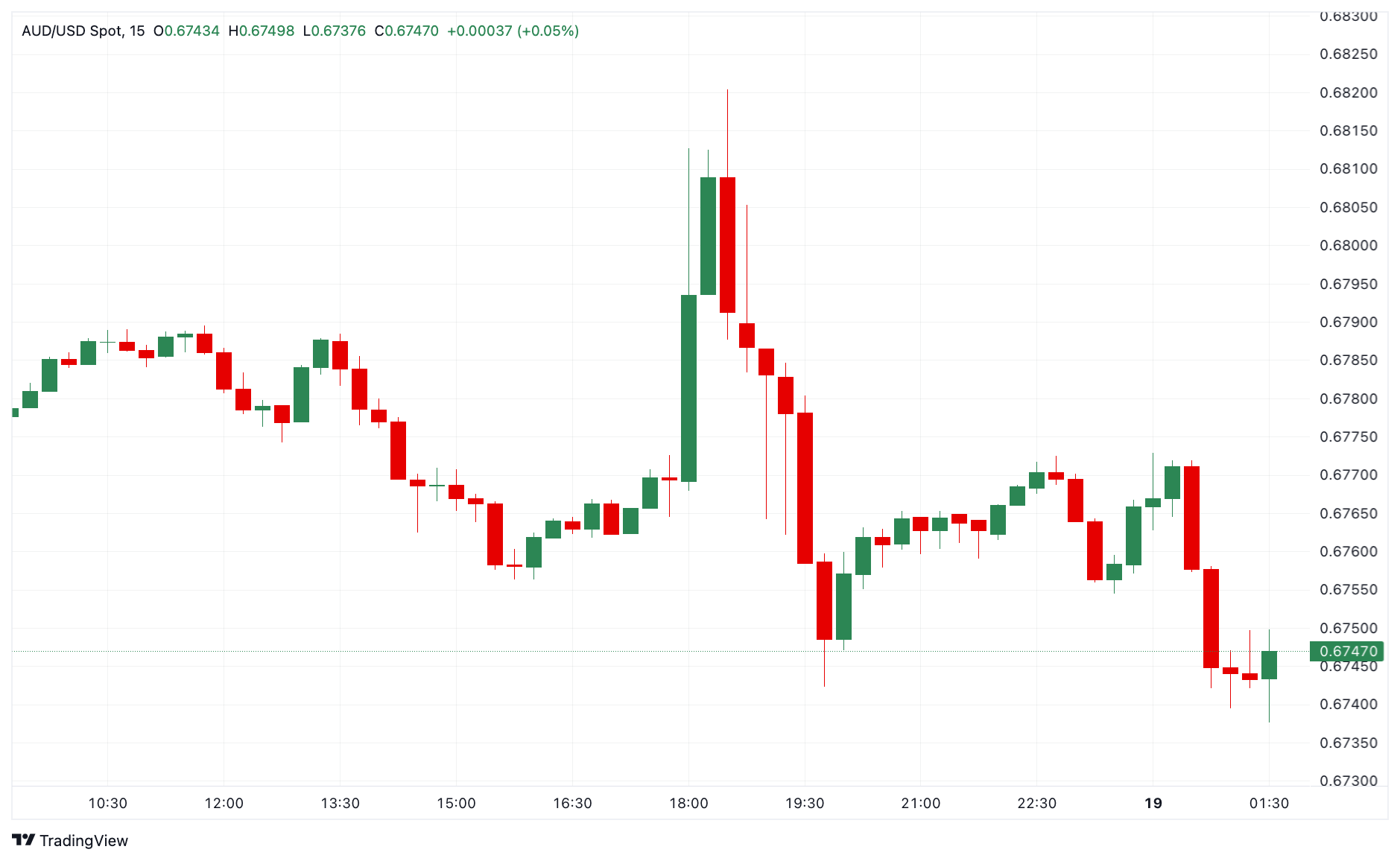Australia’s Unemployment Rate remained at 4.2% in August, compared with the expectations and the previous figure of 4.2%, according to the official data released by the Australian Bureau of Statistics (ABS) on Thursday.
Furthermore, the Australian Employment Change arrived at 47.5K in August from 48.9K (revised from 58.2K) in July, compared with the consensus forecast of 25.0K.
The participation rate in Australia held steady 67.1% in August, compared to 67.1% in July. Meanwhile, Full-Time Employment decreased by 3.1K in the same period from 64.8K (revised from 60.5K) in the previous reading. The Part-Time Employment increased by 50.6K in July versus -15.8K (revised from -2.3K) prior.
Kate Lamb, ABS head of labour statistics, said with the key highlights noted below
The number of unemployed people fell by around 10,000, while the number of employed people grew by around 47,000, in August. This resulted in the unemployment rate remaining steady at 4.2 per cent and the participation rate remaining at its record high of 67.1 per cent.
The growth in employment increased the employment-to-population ratio by 0.1 percentage point to 64.3 per cent, which is just below the November 2023 historical high of 64.4 per cent.
While the number of unemployed people fell slightly to 627,000 in August, it has risen by around 45,000 people since the end of 2023.
AUD/USD reaction to the Australia Employment report
The Australia Employment report provides little to no impact on the Australian Dollar. The AUD/USD pair is trading at 0.6745, losing 0.27% on the day.
(This story was corrected on September 19 at 09:30 GMT to update the revised numbers for Employment Change, Full-time, and Part-time Employment data for July.)
Australian Dollar price today
The table below shows the percentage change of Australian Dollar (AUD) against listed major currencies today. Australian Dollar was the weakest against the US Dollar.
| USD | EUR | GBP | CAD | AUD | JPY | NZD | CHF | |
| USD | 0.35% | 0.30% | 0.24% | 0.28% | 0.81% | 0.34% | 0.37% | |
| EUR | -0.34% | -0.05% | -0.11% | -0.06% | 0.48% | -0.01% | 0.03% | |
| GBP | -0.31% | 0.06% | -0.06% | -0.02% | 0.55% | 0.04% | 0.09% | |
| CAD | -0.24% | 0.09% | 0.05% | 0.04% | 0.61% | 0.10% | 0.16% | |
| AUD | -0.28% | 0.06% | 0.03% | -0.04% | 0.53% | 0.06% | 0.09% | |
| JPY | -0.81% | -0.55% | -0.56% | -0.57% | -0.49% | -0.53% | -0.29% | |
| NZD | -0.36% | 0.03% | -0.06% | -0.10% | -0.07% | 0.46% | 0.08% | |
| CHF | -0.36% | -0.02% | -0.09% | -0.16% | -0.08% | 0.45% | -0.02% |
The heat map shows percentage changes of major currencies against each other. The base currency is picked from the left column, while the quote currency is picked from the top row. For example, if you pick the Euro from the left column and move along the horizontal line to the Japanese Yen, the percentage change displayed in the box will represent EUR (base)/JPY (quote).
This section below was published at 21:30 GMT on Thursday as a preview of the Australia Employment report
- The Australian Unemployment Rate is foreseen unchanged at 4.2% in August.
- Employment Change is expected at 25K, more than halving the 58.2K posted in July.
- AUD/USD stands below 0.6800, with a bullish bias in the Federal Reserve’s aftermath.
The Australian Bureau of Statistics (ABS) will release the monthly employment report at 1:30 GMT on Thursday. The country is expected to have added 25K new positions in August, while the Unemployment Rate is foreseen to remain steady at 4.2%. The Australian Dollar (AUD) heads into the event with a firmer tone against its United States (US) rival, with AUD/USD hovering around the 06770 level.
The ABS reports Employment Change separating full-time from part-time positions. According to its own definitions, full-time jobs imply working 38 hours per week or more and usually include additional benefits, but they mostly represent consistent income. On the other hand, part-time employment generally means higher hourly rates but lacks consistency and benefits. That’s why full-time jobs have more weight than part-time ones when setting an AUD directional path.
Back in July, the monthly employment report showed that Australia managed to create 60.5K full-time jobs while losing 2.3K part-time positions, resulting in a net Employment Change of 58.2K. The Unemployment Rate, in the meantime, rose to 4.2% from 4.1% prior.
Australian Unemployment Rate seen stable, but high in August
As previously noted, financial markets anticipate the Unemployment Rate to be at 4.2%, unchanged on a monthly basis. Job creation is expected to continue, albeit at a slower pace.
The Australian Unemployment rate jumped to 4.2% in July, which seems good news from the Reserve Bank of Australia (RBA) as it’s a sign of a loosening labor market, which eventually will back up an interest rate cut.
The RBA has maintained the Official Cash Rate (OCR) at 4.35% since lifting it to such a level in November 2023, being among those central banks that show no interest in trimming interest rates.
And there is a good reason: The Australian inflation rate rose to 3.8% year-on-year (YoY) in the second quarter of the year, matching expectations yet higher than the 3.6% posted in Q1. It was the first acceleration in the annual Consumer Price Index (CPI) since 2022 amid higher inflation for both goods and services.
Indeed, growth remains sluggish in the country. According to the latest Gross Domestic Product (GDP) release, the economy grew a modest 1% YoY in the second quarter of the year. Taking the 2023-24 financial year as a whole, the economy expanded 1.5%, the weakest since the 1991-92 year, excluding the 0.3% contraction during the pandemic-disrupted year, the ABS stated.
Finally, it is worth noting that RBA Governor Michele Bullock said that market expectations for an interest rate cut “don’t align” with the Board’s thinking. Even further, Bullock noted she is doing her job, which is to tame inflation, suggesting policymakers are not putting economic performance above their mandate.
“If the economy evolves broadly as anticipated, the Board does not expect that it will be in a position to cut rates in the near term,” Bullock added.
When will the Australian employment report be released, and how could it affect AUD/USD?
The ABS will publish the August employment report early on Thursday. As previously stated, Australia is expected to have added 25K new job positions in the month, while the Unemployment Rate is foreseen at 4.2%. Finally, the Participation Rate is expected to hold at 67.1%.
The AUD/USD pair trades near the 0.6800 price zone ahead of the event and following the Federal Reserve’s (Fed) monetary policy decision. The US central bank went for an aggressive 50 basis points (bps) interest rate cut, with the overall decision being more dovish than anticipated. Financial markets welcomed the news and sold the Greenback, while stock markets rose, underpinning AUD/USD.
After the dust settled, stocks trimmed Fed-inspired gains and helped the US Dollar to recover against its major rivals. From a technical perspective, Valeria Bednarik, Chief Analyst at FXStreet, notes: “The AUD/USD pair is bullish and trades near its recent highs at 0.6823. The pair can reach the level on a better-than-anticipated August employment report. December high at 0.6870 is the next level to watch and a potential bullish target, although the figures really have to rock markets to spur such a rally.”
Bednarik adds: “AUD/USD will likely trade on mood. DIscouraging employment figures may have a negative effect on the AUD/USD pair. Support can be found in the 0.6740 region ahead of the 0.6700 threshold.”
Employment FAQs
Labor market conditions are a key element in assessing the health of an economy and thus a key driver for currency valuation. High employment, or low unemployment, has positive implications for consumer spending and economic growth, boosting the value of the local currency. Moreover, a very tight labor market – a situation in which there is a shortage of workers to fill open positions – can also have implications on inflation levels because low labor supply and high demand leads to higher wages.
The pace at which salaries are growing in an economy is key for policymakers. High wage growth means that households have more money to spend, usually leading to price increases in consumer goods. In contrast to more volatile sources of inflation such as energy prices, wage growth is seen as a key component of underlying and persisting inflation as salary increases are unlikely to be undone. Central banks around the world pay close attention to wage growth data when deciding on monetary policy.
The weight that each central bank assigns to labor market conditions depends on its objectives. Some central banks explicitly have mandates related to the labor market beyond controlling inflation levels. The US Federal Reserve (Fed), for example, has the dual mandate of promoting maximum employment and stable prices. Meanwhile, the European Central Bank’s (ECB) sole mandate is to keep inflation under control. Still, and despite whatever mandates they have, labor market conditions are an important factor for policymakers given their significance as a gauge of the health of the economy and their direct relationship to inflation.Quantitative tightening (QT) is the reverse of QE. It is undertaken after QE when an economic recovery is underway and inflation starts rising. Whilst in QE the Reserve Bank of Australia (RBA) purchases government and corporate bonds from financial institutions to provide them with liquidity, in QT the RBA stops buying more assets, and stops reinvesting the principal maturing on the bonds it already holds. It would be positive (or bullish) for the Australian Dollar.The weight that each central bank assigns to labor market conditions depends on its objectives. Some central banks explicitly have mandates related to the labor market beyond controlling inflation levels. The US Federal Reserve (Fed), for example, has the dual mandate of promoting maximum employment and stable prices. Meanwhile, the European Central Bank’s (ECB) sole mandate is to keep inflation under control. Still, and despite whatever mandates they have, labor market conditions are an important factor for policymakers given their significance as a gauge of the health of the economy and their direct relationship to inflation.The Trade Balance, which is the difference between what a country earns from its exports versus what it pays for its imports, is another factor that can influence the value of the Australian Dollar. If Australia produces highly sought after exports, then its currency will gain in value purely from the surplus demand created from foreign buyers seeking to purchase its exports versus what it spends to purchase imports. Therefore, a positive net Trade Balance strengthens the AUD, with the opposite effect if the Trade Balance is negative.
Economic Indicator
Unemployment Rate s.a.
The Unemployment Rate, released by the Australian Bureau of Statistics, is the number of unemployed workers divided by the total civilian labor force, expressed as a percentage. If the rate increases, it indicates a lack of expansion within the Australian labor market and a weakness within the Australian economy. A decrease in the figure is seen as bullish for the Australian Dollar (AUD), while an increase is seen as bearish.
Read more.Next release: Thu Sep 19, 2024 01:30
Frequency: Monthly
Consensus: 4.2%
Previous: 4.2%
Source: Australian Bureau of Statistics
The Australian Bureau of Statistics (ABS) publishes an overview of trends in the Australian labour market, with unemployment rate a closely watched indicator. It is released about 15 days after the month end and throws light on the overall economic conditions, as it is highly correlated to consumer spending and inflation. Despite the lagging nature of the indicator, it affects the Reserve Bank of Australia’s (RBA) interest rate decisions, in turn, moving the Australian dollar. Upbeat figure tends to be AUD positive.
Information on these pages contains forward-looking statements that involve risks and uncertainties. Markets and instruments profiled on this page are for informational purposes only and should not in any way come across as a recommendation to buy or sell in these assets. You should do your own thorough research before making any investment decisions. FXStreet does not in any way guarantee that this information is free from mistakes, errors, or material misstatements. It also does not guarantee that this information is of a timely nature. Investing in Open Markets involves a great deal of risk, including the loss of all or a portion of your investment, as well as emotional distress. All risks, losses and costs associated with investing, including total loss of principal, are your responsibility. The views and opinions expressed in this article are those of the authors and do not necessarily reflect the official policy or position of FXStreet nor its advertisers. The author will not be held responsible for information that is found at the end of links posted on this page.
If not otherwise explicitly mentioned in the body of the article, at the time of writing, the author has no position in any stock mentioned in this article and no business relationship with any company mentioned. The author has not received compensation for writing this article, other than from FXStreet.
FXStreet and the author do not provide personalized recommendations. The author makes no representations as to the accuracy, completeness, or suitability of this information. FXStreet and the author will not be liable for any errors, omissions or any losses, injuries or damages arising from this information and its display or use. Errors and omissions excepted.
The author and FXStreet are not registered investment advisors and nothing in this article is intended to be investment advice.
Recommended content
Editors’ Picks

AUD/USD tumbles to a five-year low below 0.6000 amid US-China tariffs war
The AUD/USD pair tumbles to near 0.5985 for the first time since the COVID-19 pandemic during the early Asian session on Monday. The Australian Dollar weakens as China slapped a 34% tax on all US imports in retaliation for US President Donald Trump’s tariffs, raising fear of a trade war between the United States and China.

USD/JPY hangs near a multi-month low; holds above 145.00 amid mixed cues
USD/JPY kicks off the new week on a weaker note, though it manages to hold above the 145.00 mark. The global carnage, amid the mounting risk of a recession led by Trump's sweeping tariffs, underpins the safe-haven JPY and weighs on the currency pair amid a bearish USD.

Gold correction deepens after new record-high is set on Trump’s tariff announcement
Gold pushed higher with the initial reaction to tariff announcements from the United States on Wednesday and touched a record peak of $3,167 before staging a deep correction heading into the weekend. Investors will stay focused on tariff-related headlines and pay close attention to inflation data from the US.

Week ahead: US CPI and RBNZ decision on tap amidst tariff mayhem
US Dollar traders await US CPI data amid global trade turbulence. RBNZ to cut by 25bps, could maintain dovish stance. China’s CPI and PPI to reveal tariff impact on inflation. Strong UK GDP data could help the pound climb higher.

Strategic implications of “Liberation Day”
Liberation Day in the United States came with extremely protectionist and inward-looking tariff policy aimed at just about all U.S. trading partners. In this report, we outline some of the more strategic implications of Liberation Day and developments we will be paying close attention to going forward.

The Best brokers to trade EUR/USD
SPONSORED Discover the top brokers for trading EUR/USD in 2025. Our list features brokers with competitive spreads, fast execution, and powerful platforms. Whether you're a beginner or an expert, find the right partner to navigate the dynamic Forex market.




